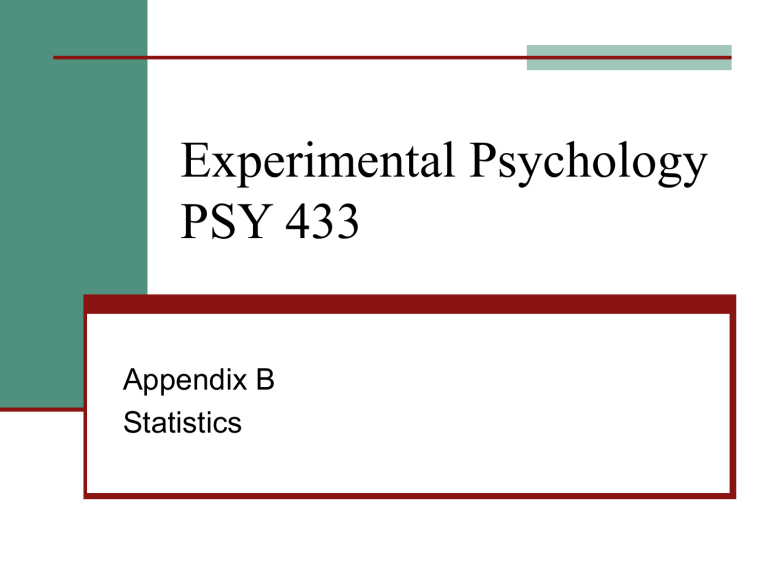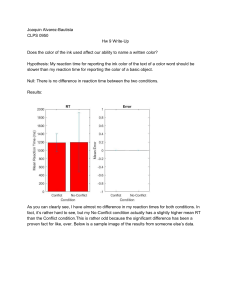
Experimental Psychology PSY 433 Appendix B Statistics Goals for the Experimenter Create the strongest effect possible: Increase the number of subjects Improve the stimuli and task (e.g., increase trials, change manipulation) Reduce “noise” – unwanted variance: Control as much as possible Make sure all subjects have the same experience (except for the manipulation) Eliminate confounds – the only explanation should be the “alternative explanation Descriptive & Inferential Statistics Descriptive statistics -- organize, summarize & describe data. Inferential statistics -- make inferences about a large group based on data from a small portion of those people The large group is called the population. The small portion is called the sample. We generalize from the sample to the population. Samples and Populations Example: Randomly assign 100 students to 2 groups of 50 One group gets a drug and the other a placebo. Test both groups’ memory for 80 words. Mean # of words recalled: drug = 48, placebo = 42. What are the samples and what are the populations? What can be inferred about the population? Null & Alternative Hypotheses Does the drug improve memory in students? There are two possibilities: The drug has no effect and the difference between sample means reflects random chance (null hypothesis) The drug improves memory and the difference between sample means reflects the presence of two different populations (alternative hypothesis). Hypothesis Testing We first assume there is no effect of the drug on memory (null hypothesis) We then look at the difference between sample means & ask: how likely is this difference if the null hypothesis is true? Small differences are likely (due to chance), so the null hypothesis (no difference) could be true. Large differences are unlikely, so we reject the null hypothesis and decide the drug most likely did affect memory. Significance Level We reject the null hypothesis if there is a “large difference” between sample means But what’s a “large difference?” A “large difference” is one that would occur less than 5% of the time by chance alone (significance level, or p < .05) This is called a significant difference. Kinds of Descriptive Statistics Measures of central tendency – use a single number to describe the group. Useful for comparing between multiple groups. Mean, median, mode. Measures of dispersion – quantifies how much the values are spread out or distant from the mean. Range Variance Standard deviation Inferential Statistics Used to test difference between means or between a mean and some other number. Answers the question: could this result have occurred due to chance (normal variability)? Compares the observed values against what typically occurs with repeated sampling – the normal distribution. Standard error of the mean – a standard deviation for the means of all possible samples from a population. Kinds of Inferential Tests Tests for a single group against a known value: Single group z-test or t-test Tests for differences between two groups: Independent groups t-test Repeated measures (paired groups) t-test Tests for difference between several groups: ANOVA – for one IV (one-way) Repeated measures ANOVA Multi-factor ANOVA Nonparametric Tests When data is not normally distributed then the assumptions about what might occur due to chance are different. Two choices: Convert data to normal distribution. Minimize the odd distribution and make it more closely normal by using the rank orders of the observations instead of their actual values. Slightly different tests are required -- each test has a non-parametric equivalent.





